Process Technology and Competitive Strategy: Intel Case Study
VerifiedAdded on 2021/10/29
|18
|4679
|386
Report
AI Summary
This report provides a comprehensive analysis of Intel's process technology, emphasizing its significance in achieving competitive advantage. It delves into the core concepts of process technology in manufacturing and service companies, highlighting its role in converting inputs to outputs and enabling product differentiation. The report explains the experience curve and its formulation, emphasizing its relevance in new product development and large-scale projects. It examines the product-process matrix as a tool for aligning processes with product needs, exploring the trade-offs between flexibility and efficiency. Furthermore, the report discusses process technology strategy decisions, including choosing appropriate technologies based on automation, flexibility, and scalability. It outlines various considerations for automation decisions, encompassing business, operational, social, political, and regulatory issues. Finally, the report emphasizes the importance of aligning process technology choices with the firm's strategic position and the need to evaluate technology options economically.
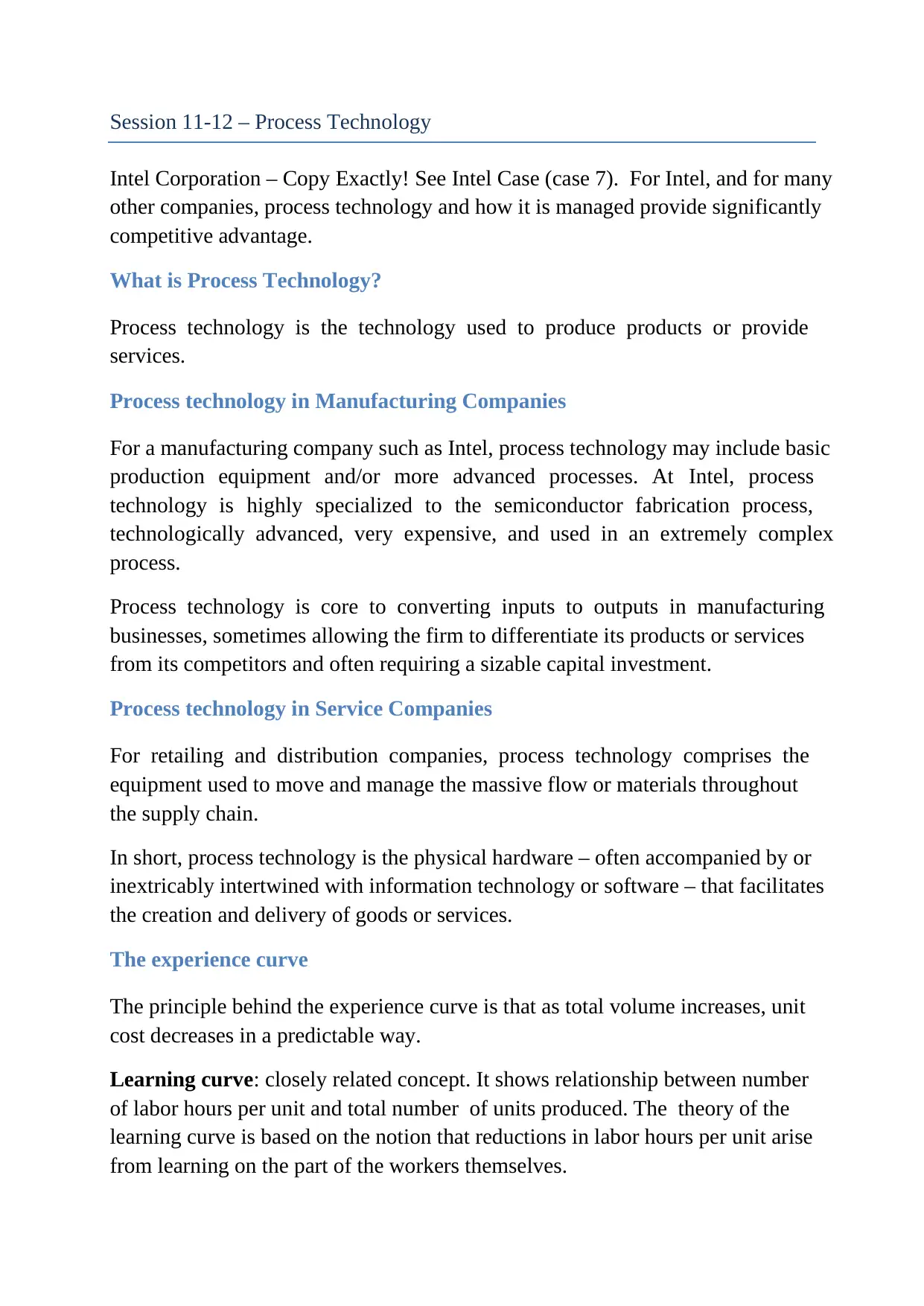
Session 11-12 – Process Technology
Intel Corporation – Copy Exactly! See Intel Case (case 7). For Intel, and for many
other companies, process technology and how it is managed provide significantly
competitive advantage.
What is Process Technology?
Process technology is the technology used to produce products or provide
services.
Process technology in Manufacturing Companies
For a manufacturing company such as Intel, process technology may include basic
production equipment and/or more advanced processes. At Intel, process
technology is highly specialized to the semiconductor fabrication process,
technologically advanced, very expensive, and used in an extremely complex
process.
Process technology is core to converting inputs to outputs in manufacturing
businesses, sometimes allowing the firm to differentiate its products or services
from its competitors and often requiring a sizable capital investment.
Process technology in Service Companies
For retailing and distribution companies, process technology comprises the
equipment used to move and manage the massive flow or materials throughout
the supply chain.
In short, process technology is the physical hardware – often accompanied by or
inextricably intertwined with information technology or software – that facilitates
the creation and delivery of goods or services.
The experience curve
The principle behind the experience curve is that as total volume increases, unit
cost decreases in a predictable way.
Learning curve: closely related concept. It shows relationship between number
of labor hours per unit and total number of units produced. The theory of the
learning curve is based on the notion that reductions in labor hours per unit arise
from learning on the part of the workers themselves.
Intel Corporation – Copy Exactly! See Intel Case (case 7). For Intel, and for many
other companies, process technology and how it is managed provide significantly
competitive advantage.
What is Process Technology?
Process technology is the technology used to produce products or provide
services.
Process technology in Manufacturing Companies
For a manufacturing company such as Intel, process technology may include basic
production equipment and/or more advanced processes. At Intel, process
technology is highly specialized to the semiconductor fabrication process,
technologically advanced, very expensive, and used in an extremely complex
process.
Process technology is core to converting inputs to outputs in manufacturing
businesses, sometimes allowing the firm to differentiate its products or services
from its competitors and often requiring a sizable capital investment.
Process technology in Service Companies
For retailing and distribution companies, process technology comprises the
equipment used to move and manage the massive flow or materials throughout
the supply chain.
In short, process technology is the physical hardware – often accompanied by or
inextricably intertwined with information technology or software – that facilitates
the creation and delivery of goods or services.
The experience curve
The principle behind the experience curve is that as total volume increases, unit
cost decreases in a predictable way.
Learning curve: closely related concept. It shows relationship between number
of labor hours per unit and total number of units produced. The theory of the
learning curve is based on the notion that reductions in labor hours per unit arise
from learning on the part of the workers themselves.
Paraphrase This Document
Need a fresh take? Get an instant paraphrase of this document with our AI Paraphraser
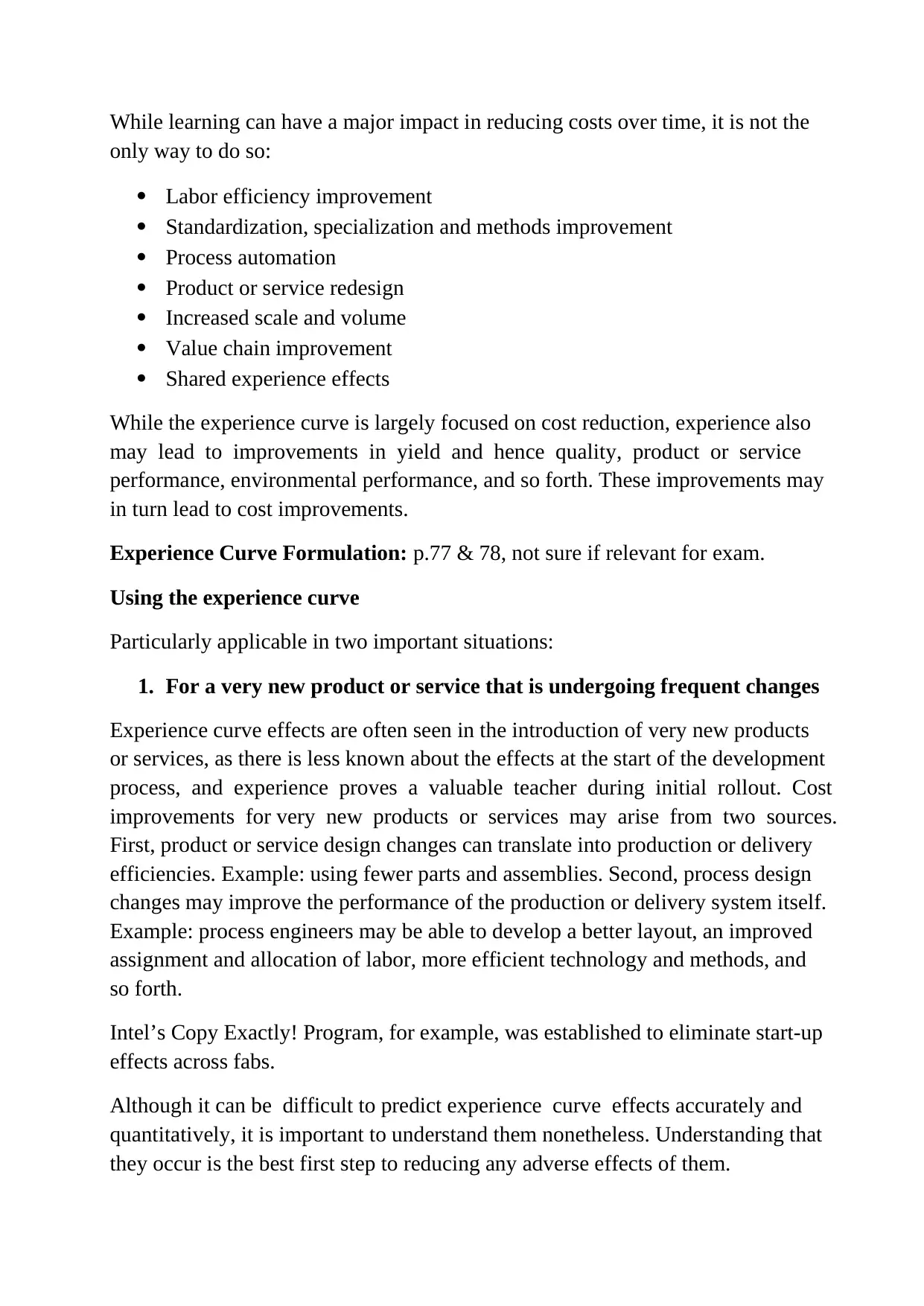
While learning can have a major impact in reducing costs over time, it is not the
only way to do so:
Labor efficiency improvement
Standardization, specialization and methods improvement
Process automation
Product or service redesign
Increased scale and volume
Value chain improvement
Shared experience effects
While the experience curve is largely focused on cost reduction, experience also
may lead to improvements in yield and hence quality, product or service
performance, environmental performance, and so forth. These improvements may
in turn lead to cost improvements.
Experience Curve Formulation: p.77 & 78, not sure if relevant for exam.
Using the experience curve
Particularly applicable in two important situations:
1. For a very new product or service that is undergoing frequent changes
Experience curve effects are often seen in the introduction of very new products
or services, as there is less known about the effects at the start of the development
process, and experience proves a valuable teacher during initial rollout. Cost
improvements for very new products or services may arise from two sources.
First, product or service design changes can translate into production or delivery
efficiencies. Example: using fewer parts and assemblies. Second, process design
changes may improve the performance of the production or delivery system itself.
Example: process engineers may be able to develop a better layout, an improved
assignment and allocation of labor, more efficient technology and methods, and
so forth.
Intel’s Copy Exactly! Program, for example, was established to eliminate start-up
effects across fabs.
Although it can be difficult to predict experience curve effects accurately and
quantitatively, it is important to understand them nonetheless. Understanding that
they occur is the best first step to reducing any adverse effects of them.
only way to do so:
Labor efficiency improvement
Standardization, specialization and methods improvement
Process automation
Product or service redesign
Increased scale and volume
Value chain improvement
Shared experience effects
While the experience curve is largely focused on cost reduction, experience also
may lead to improvements in yield and hence quality, product or service
performance, environmental performance, and so forth. These improvements may
in turn lead to cost improvements.
Experience Curve Formulation: p.77 & 78, not sure if relevant for exam.
Using the experience curve
Particularly applicable in two important situations:
1. For a very new product or service that is undergoing frequent changes
Experience curve effects are often seen in the introduction of very new products
or services, as there is less known about the effects at the start of the development
process, and experience proves a valuable teacher during initial rollout. Cost
improvements for very new products or services may arise from two sources.
First, product or service design changes can translate into production or delivery
efficiencies. Example: using fewer parts and assemblies. Second, process design
changes may improve the performance of the production or delivery system itself.
Example: process engineers may be able to develop a better layout, an improved
assignment and allocation of labor, more efficient technology and methods, and
so forth.
Intel’s Copy Exactly! Program, for example, was established to eliminate start-up
effects across fabs.
Although it can be difficult to predict experience curve effects accurately and
quantitatively, it is important to understand them nonetheless. Understanding that
they occur is the best first step to reducing any adverse effects of them.
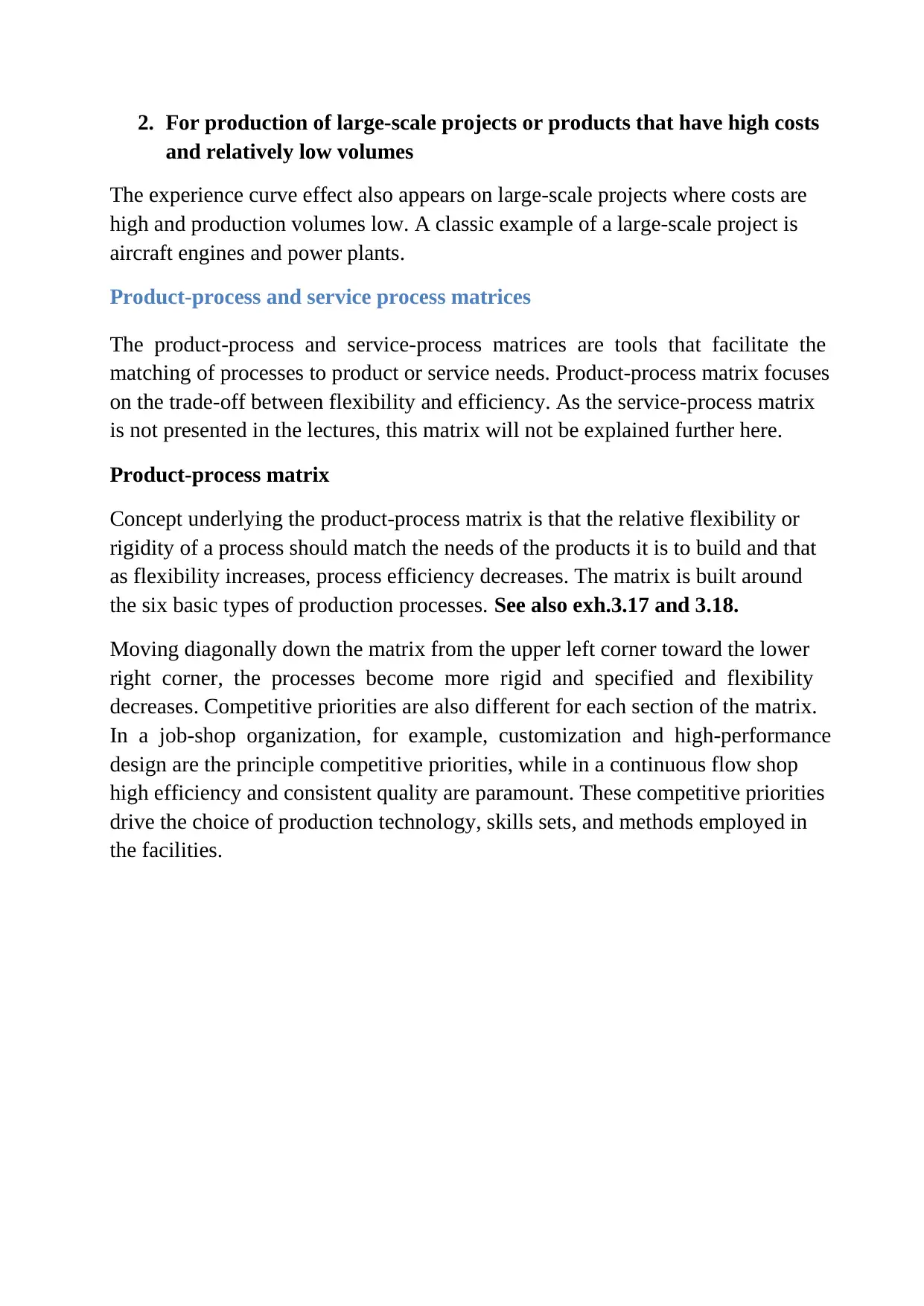
2. For production of large-scale projects or products that have high costs
and relatively low volumes
The experience curve effect also appears on large-scale projects where costs are
high and production volumes low. A classic example of a large-scale project is
aircraft engines and power plants.
Product-process and service process matrices
The product-process and service-process matrices are tools that facilitate the
matching of processes to product or service needs. Product-process matrix focuses
on the trade-off between flexibility and efficiency. As the service-process matrix
is not presented in the lectures, this matrix will not be explained further here.
Product-process matrix
Concept underlying the product-process matrix is that the relative flexibility or
rigidity of a process should match the needs of the products it is to build and that
as flexibility increases, process efficiency decreases. The matrix is built around
the six basic types of production processes. See also exh.3.17 and 3.18.
Moving diagonally down the matrix from the upper left corner toward the lower
right corner, the processes become more rigid and specified and flexibility
decreases. Competitive priorities are also different for each section of the matrix.
In a job-shop organization, for example, customization and high-performance
design are the principle competitive priorities, while in a continuous flow shop
high efficiency and consistent quality are paramount. These competitive priorities
drive the choice of production technology, skills sets, and methods employed in
the facilities.
and relatively low volumes
The experience curve effect also appears on large-scale projects where costs are
high and production volumes low. A classic example of a large-scale project is
aircraft engines and power plants.
Product-process and service process matrices
The product-process and service-process matrices are tools that facilitate the
matching of processes to product or service needs. Product-process matrix focuses
on the trade-off between flexibility and efficiency. As the service-process matrix
is not presented in the lectures, this matrix will not be explained further here.
Product-process matrix
Concept underlying the product-process matrix is that the relative flexibility or
rigidity of a process should match the needs of the products it is to build and that
as flexibility increases, process efficiency decreases. The matrix is built around
the six basic types of production processes. See also exh.3.17 and 3.18.
Moving diagonally down the matrix from the upper left corner toward the lower
right corner, the processes become more rigid and specified and flexibility
decreases. Competitive priorities are also different for each section of the matrix.
In a job-shop organization, for example, customization and high-performance
design are the principle competitive priorities, while in a continuous flow shop
high efficiency and consistent quality are paramount. These competitive priorities
drive the choice of production technology, skills sets, and methods employed in
the facilities.
⊘ This is a preview!⊘
Do you want full access?
Subscribe today to unlock all pages.

Trusted by 1+ million students worldwide
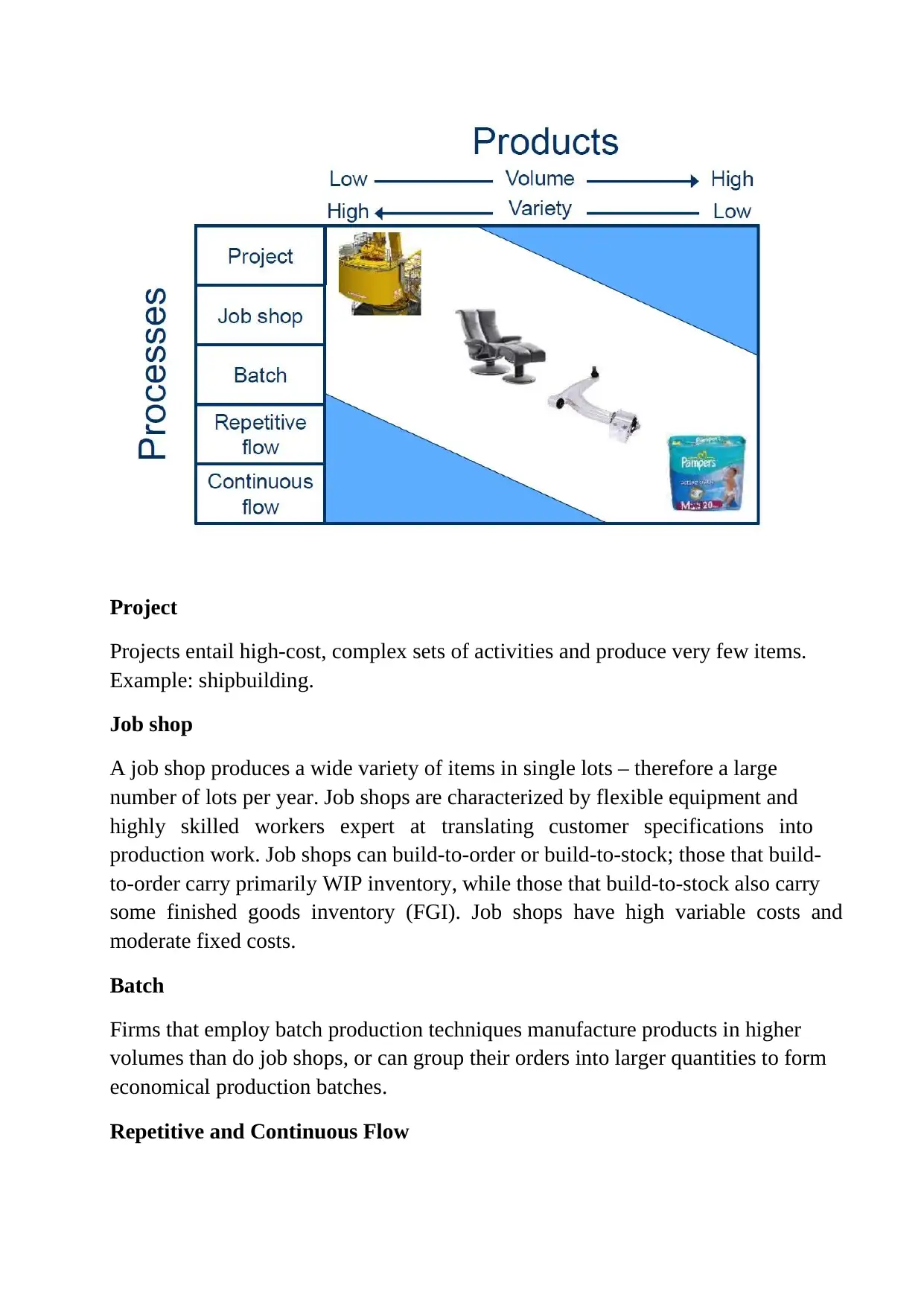
Project
Projects entail high-cost, complex sets of activities and produce very few items.
Example: shipbuilding.
Job shop
A job shop produces a wide variety of items in single lots – therefore a large
number of lots per year. Job shops are characterized by flexible equipment and
highly skilled workers expert at translating customer specifications into
production work. Job shops can build-to-order or build-to-stock; those that build-
to-order carry primarily WIP inventory, while those that build-to-stock also carry
some finished goods inventory (FGI). Job shops have high variable costs and
moderate fixed costs.
Batch
Firms that employ batch production techniques manufacture products in higher
volumes than do job shops, or can group their orders into larger quantities to form
economical production batches.
Repetitive and Continuous Flow
Projects entail high-cost, complex sets of activities and produce very few items.
Example: shipbuilding.
Job shop
A job shop produces a wide variety of items in single lots – therefore a large
number of lots per year. Job shops are characterized by flexible equipment and
highly skilled workers expert at translating customer specifications into
production work. Job shops can build-to-order or build-to-stock; those that build-
to-order carry primarily WIP inventory, while those that build-to-stock also carry
some finished goods inventory (FGI). Job shops have high variable costs and
moderate fixed costs.
Batch
Firms that employ batch production techniques manufacture products in higher
volumes than do job shops, or can group their orders into larger quantities to form
economical production batches.
Repetitive and Continuous Flow
Paraphrase This Document
Need a fresh take? Get an instant paraphrase of this document with our AI Paraphraser
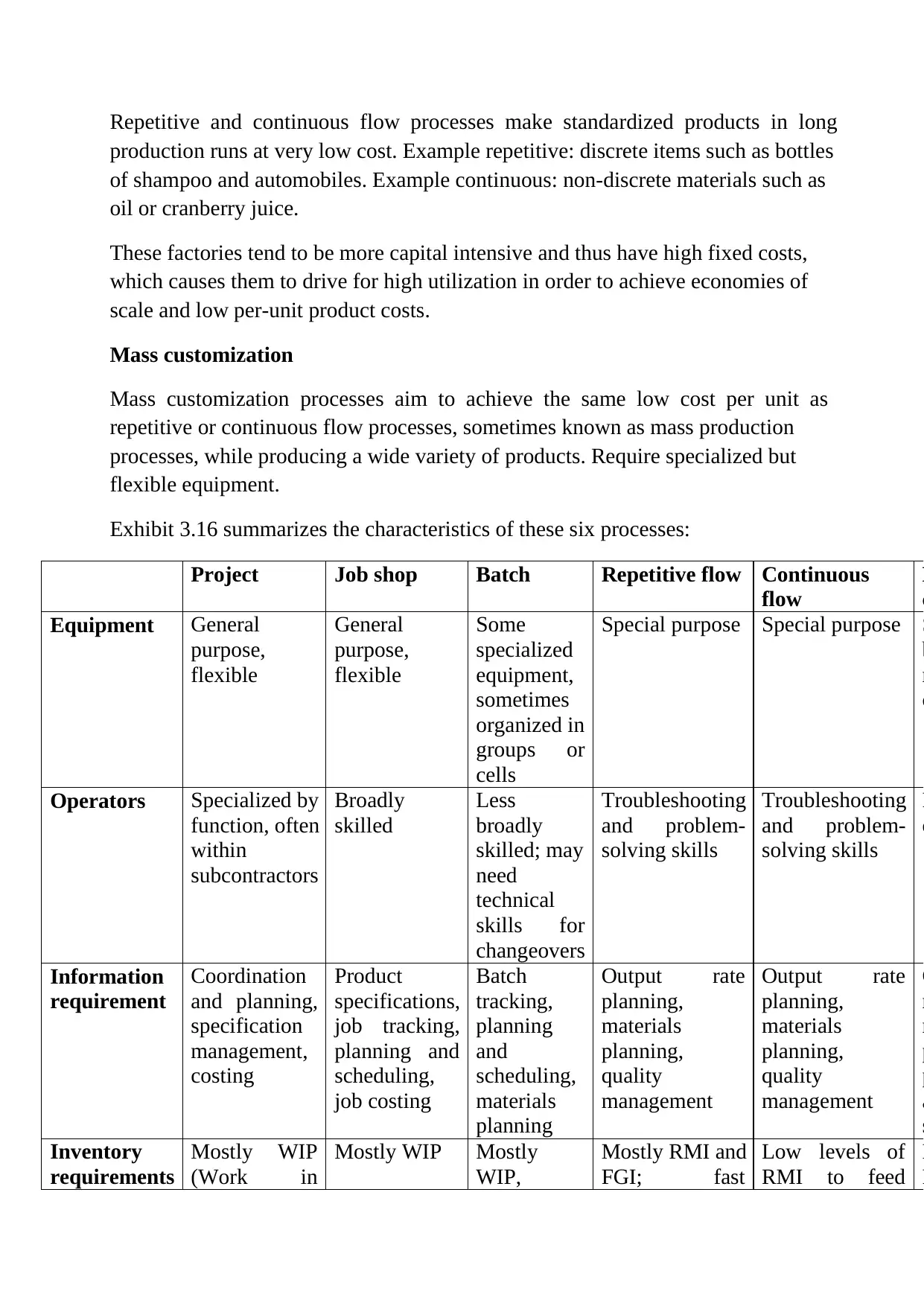
Repetitive and continuous flow processes make standardized products in long
production runs at very low cost. Example repetitive: discrete items such as bottles
of shampoo and automobiles. Example continuous: non-discrete materials such as
oil or cranberry juice.
These factories tend to be more capital intensive and thus have high fixed costs,
which causes them to drive for high utilization in order to achieve economies of
scale and low per-unit product costs.
Mass customization
Mass customization processes aim to achieve the same low cost per unit as
repetitive or continuous flow processes, sometimes known as mass production
processes, while producing a wide variety of products. Require specialized but
flexible equipment.
Exhibit 3.16 summarizes the characteristics of these six processes:
Project Job shop Batch Repetitive flow Continuous
flow
M
c
Equipment General
purpose,
flexible
General
purpose,
flexible
Some
specialized
equipment,
sometimes
organized in
groups or
cells
Special purpose Special purpose S
b
r
c
Operators Specialized by
function, often
within
subcontractors
Broadly
skilled
Less
broadly
skilled; may
need
technical
skills for
changeovers
Troubleshooting
and problem-
solving skills
Troubleshooting
and problem-
solving skills
F
o
Information
requirement
Coordination
and planning,
specification
management,
costing
Product
specifications,
job tracking,
planning and
scheduling,
job costing
Batch
tracking,
planning
and
scheduling,
materials
planning
Output rate
planning,
materials
planning,
quality
management
Output rate
planning,
materials
planning,
quality
management
C
r
m
p
p
a
s
Inventory
requirements
Mostly WIP
(Work in
Mostly WIP Mostly
WIP,
Mostly RMI and
FGI; fast
Low levels of
RMI to feed
L
R
production runs at very low cost. Example repetitive: discrete items such as bottles
of shampoo and automobiles. Example continuous: non-discrete materials such as
oil or cranberry juice.
These factories tend to be more capital intensive and thus have high fixed costs,
which causes them to drive for high utilization in order to achieve economies of
scale and low per-unit product costs.
Mass customization
Mass customization processes aim to achieve the same low cost per unit as
repetitive or continuous flow processes, sometimes known as mass production
processes, while producing a wide variety of products. Require specialized but
flexible equipment.
Exhibit 3.16 summarizes the characteristics of these six processes:
Project Job shop Batch Repetitive flow Continuous
flow
M
c
Equipment General
purpose,
flexible
General
purpose,
flexible
Some
specialized
equipment,
sometimes
organized in
groups or
cells
Special purpose Special purpose S
b
r
c
Operators Specialized by
function, often
within
subcontractors
Broadly
skilled
Less
broadly
skilled; may
need
technical
skills for
changeovers
Troubleshooting
and problem-
solving skills
Troubleshooting
and problem-
solving skills
F
o
Information
requirement
Coordination
and planning,
specification
management,
costing
Product
specifications,
job tracking,
planning and
scheduling,
job costing
Batch
tracking,
planning
and
scheduling,
materials
planning
Output rate
planning,
materials
planning,
quality
management
Output rate
planning,
materials
planning,
quality
management
C
r
m
p
p
a
s
Inventory
requirements
Mostly WIP
(Work in
Mostly WIP Mostly
WIP,
Mostly RMI and
FGI; fast
Low levels of
RMI to feed
L
R
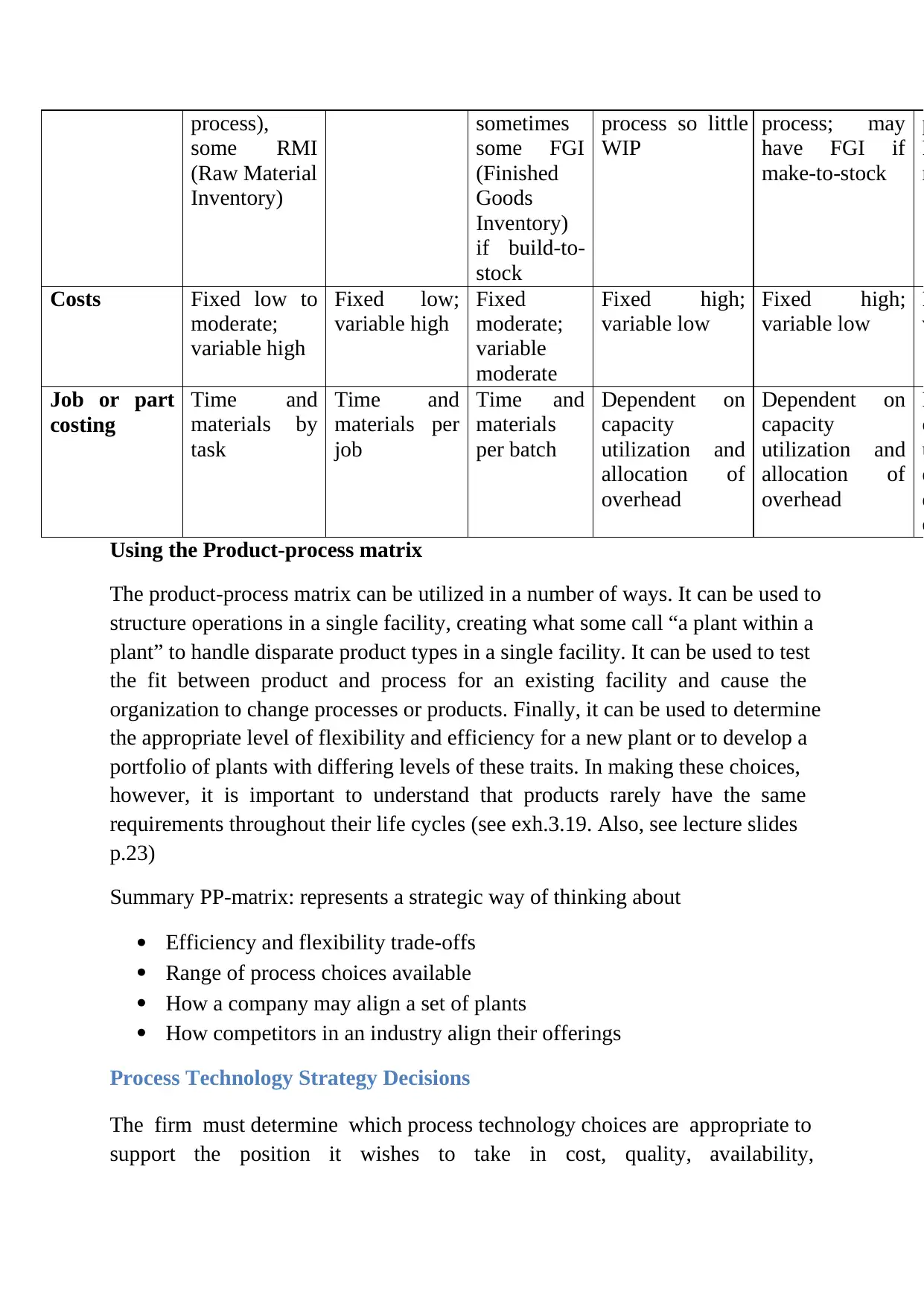
process),
some RMI
(Raw Material
Inventory)
sometimes
some FGI
(Finished
Goods
Inventory)
if build-to-
stock
process so little
WIP
process; may
have FGI if
make-to-stock
p
F
m
Costs Fixed low to
moderate;
variable high
Fixed low;
variable high
Fixed
moderate;
variable
moderate
Fixed high;
variable low
Fixed high;
variable low
F
v
Job or part
costing
Time and
materials by
task
Time and
materials per
job
Time and
materials
per batch
Dependent on
capacity
utilization and
allocation of
overhead
Dependent on
capacity
utilization and
allocation of
overhead
D
c
u
d
d
d
Using the Product-process matrix
The product-process matrix can be utilized in a number of ways. It can be used to
structure operations in a single facility, creating what some call “a plant within a
plant” to handle disparate product types in a single facility. It can be used to test
the fit between product and process for an existing facility and cause the
organization to change processes or products. Finally, it can be used to determine
the appropriate level of flexibility and efficiency for a new plant or to develop a
portfolio of plants with differing levels of these traits. In making these choices,
however, it is important to understand that products rarely have the same
requirements throughout their life cycles (see exh.3.19. Also, see lecture slides
p.23)
Summary PP-matrix: represents a strategic way of thinking about
Efficiency and flexibility trade-offs
Range of process choices available
How a company may align a set of plants
How competitors in an industry align their offerings
Process Technology Strategy Decisions
The firm must determine which process technology choices are appropriate to
support the position it wishes to take in cost, quality, availability,
some RMI
(Raw Material
Inventory)
sometimes
some FGI
(Finished
Goods
Inventory)
if build-to-
stock
process so little
WIP
process; may
have FGI if
make-to-stock
p
F
m
Costs Fixed low to
moderate;
variable high
Fixed low;
variable high
Fixed
moderate;
variable
moderate
Fixed high;
variable low
Fixed high;
variable low
F
v
Job or part
costing
Time and
materials by
task
Time and
materials per
job
Time and
materials
per batch
Dependent on
capacity
utilization and
allocation of
overhead
Dependent on
capacity
utilization and
allocation of
overhead
D
c
u
d
d
d
Using the Product-process matrix
The product-process matrix can be utilized in a number of ways. It can be used to
structure operations in a single facility, creating what some call “a plant within a
plant” to handle disparate product types in a single facility. It can be used to test
the fit between product and process for an existing facility and cause the
organization to change processes or products. Finally, it can be used to determine
the appropriate level of flexibility and efficiency for a new plant or to develop a
portfolio of plants with differing levels of these traits. In making these choices,
however, it is important to understand that products rarely have the same
requirements throughout their life cycles (see exh.3.19. Also, see lecture slides
p.23)
Summary PP-matrix: represents a strategic way of thinking about
Efficiency and flexibility trade-offs
Range of process choices available
How a company may align a set of plants
How competitors in an industry align their offerings
Process Technology Strategy Decisions
The firm must determine which process technology choices are appropriate to
support the position it wishes to take in cost, quality, availability,
⊘ This is a preview!⊘
Do you want full access?
Subscribe today to unlock all pages.

Trusted by 1+ million students worldwide
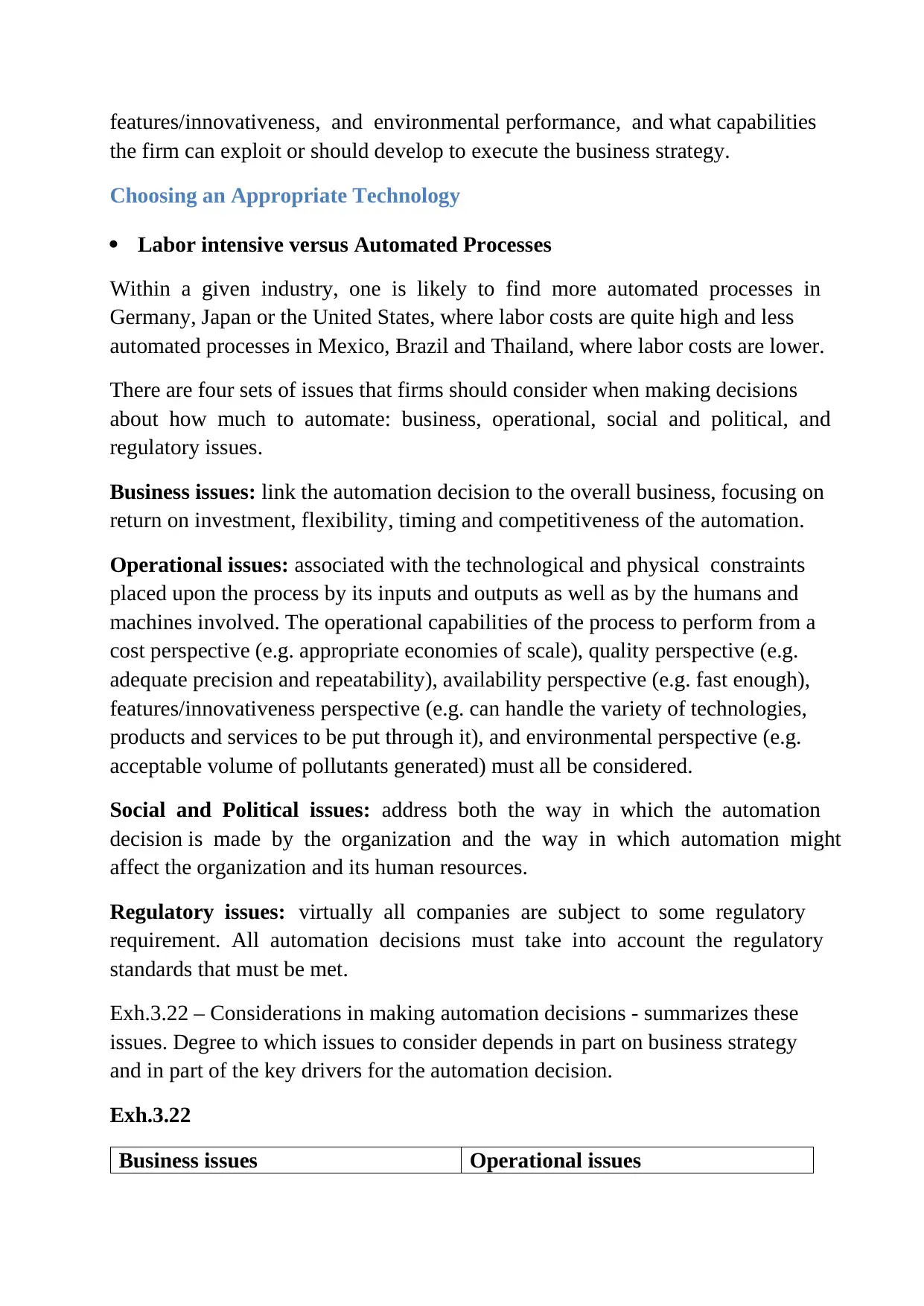
features/innovativeness, and environmental performance, and what capabilities
the firm can exploit or should develop to execute the business strategy.
Choosing an Appropriate Technology
Labor intensive versus Automated Processes
Within a given industry, one is likely to find more automated processes in
Germany, Japan or the United States, where labor costs are quite high and less
automated processes in Mexico, Brazil and Thailand, where labor costs are lower.
There are four sets of issues that firms should consider when making decisions
about how much to automate: business, operational, social and political, and
regulatory issues.
Business issues: link the automation decision to the overall business, focusing on
return on investment, flexibility, timing and competitiveness of the automation.
Operational issues: associated with the technological and physical constraints
placed upon the process by its inputs and outputs as well as by the humans and
machines involved. The operational capabilities of the process to perform from a
cost perspective (e.g. appropriate economies of scale), quality perspective (e.g.
adequate precision and repeatability), availability perspective (e.g. fast enough),
features/innovativeness perspective (e.g. can handle the variety of technologies,
products and services to be put through it), and environmental perspective (e.g.
acceptable volume of pollutants generated) must all be considered.
Social and Political issues: address both the way in which the automation
decision is made by the organization and the way in which automation might
affect the organization and its human resources.
Regulatory issues: virtually all companies are subject to some regulatory
requirement. All automation decisions must take into account the regulatory
standards that must be met.
Exh.3.22 – Considerations in making automation decisions - summarizes these
issues. Degree to which issues to consider depends in part on business strategy
and in part of the key drivers for the automation decision.
Exh.3.22
Business issues Operational issues
the firm can exploit or should develop to execute the business strategy.
Choosing an Appropriate Technology
Labor intensive versus Automated Processes
Within a given industry, one is likely to find more automated processes in
Germany, Japan or the United States, where labor costs are quite high and less
automated processes in Mexico, Brazil and Thailand, where labor costs are lower.
There are four sets of issues that firms should consider when making decisions
about how much to automate: business, operational, social and political, and
regulatory issues.
Business issues: link the automation decision to the overall business, focusing on
return on investment, flexibility, timing and competitiveness of the automation.
Operational issues: associated with the technological and physical constraints
placed upon the process by its inputs and outputs as well as by the humans and
machines involved. The operational capabilities of the process to perform from a
cost perspective (e.g. appropriate economies of scale), quality perspective (e.g.
adequate precision and repeatability), availability perspective (e.g. fast enough),
features/innovativeness perspective (e.g. can handle the variety of technologies,
products and services to be put through it), and environmental perspective (e.g.
acceptable volume of pollutants generated) must all be considered.
Social and Political issues: address both the way in which the automation
decision is made by the organization and the way in which automation might
affect the organization and its human resources.
Regulatory issues: virtually all companies are subject to some regulatory
requirement. All automation decisions must take into account the regulatory
standards that must be met.
Exh.3.22 – Considerations in making automation decisions - summarizes these
issues. Degree to which issues to consider depends in part on business strategy
and in part of the key drivers for the automation decision.
Exh.3.22
Business issues Operational issues
Paraphrase This Document
Need a fresh take? Get an instant paraphrase of this document with our AI Paraphraser
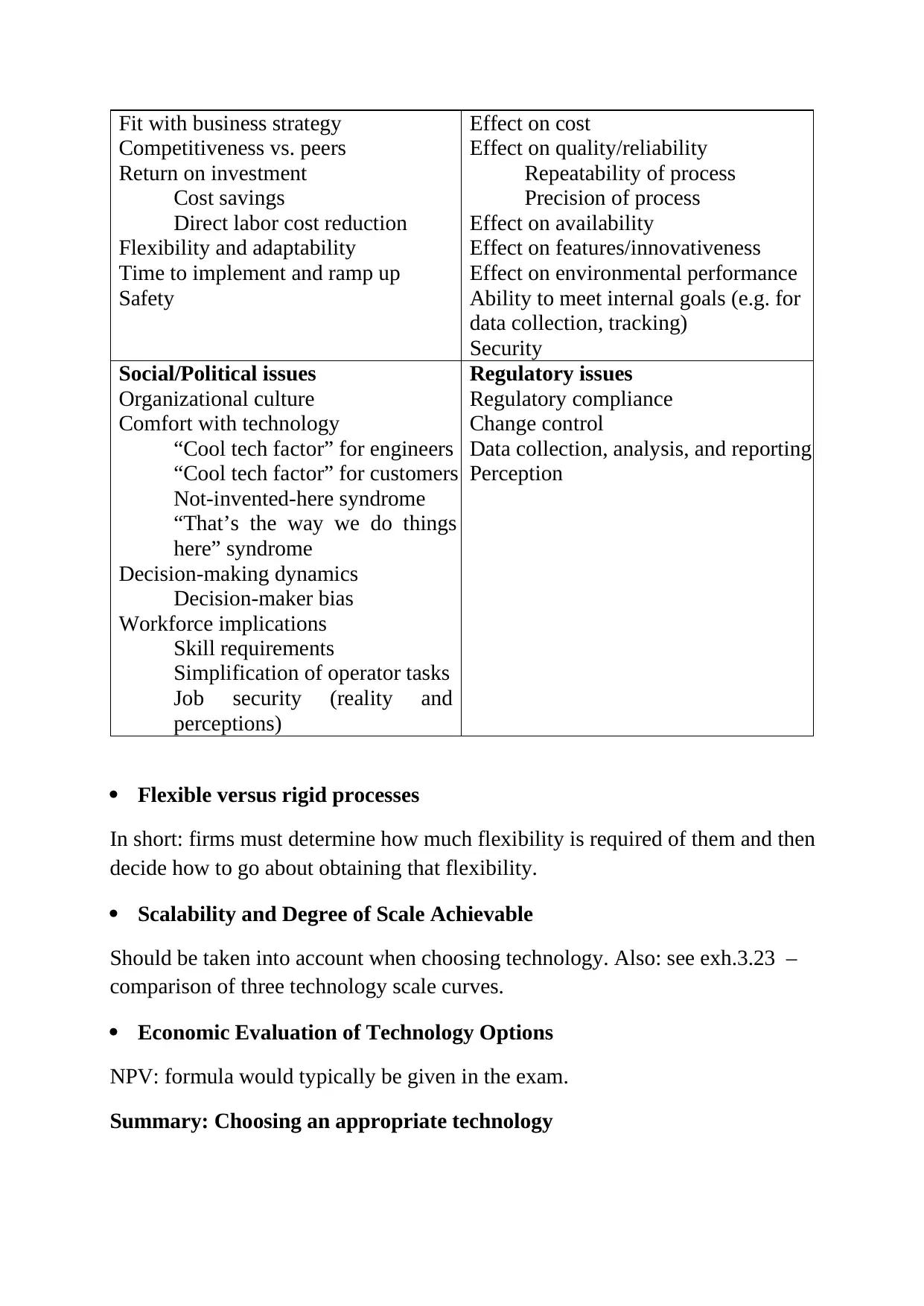
Fit with business strategy
Competitiveness vs. peers
Return on investment
Cost savings
Direct labor cost reduction
Flexibility and adaptability
Time to implement and ramp up
Safety
Effect on cost
Effect on quality/reliability
Repeatability of process
Precision of process
Effect on availability
Effect on features/innovativeness
Effect on environmental performance
Ability to meet internal goals (e.g. for
data collection, tracking)
Security
Social/Political issues
Organizational culture
Comfort with technology
“Cool tech factor” for engineers
“Cool tech factor” for customers
Not-invented-here syndrome
“That’s the way we do things
here” syndrome
Decision-making dynamics
Decision-maker bias
Workforce implications
Skill requirements
Simplification of operator tasks
Job security (reality and
perceptions)
Regulatory issues
Regulatory compliance
Change control
Data collection, analysis, and reporting
Perception
Flexible versus rigid processes
In short: firms must determine how much flexibility is required of them and then
decide how to go about obtaining that flexibility.
Scalability and Degree of Scale Achievable
Should be taken into account when choosing technology. Also: see exh.3.23 –
comparison of three technology scale curves.
Economic Evaluation of Technology Options
NPV: formula would typically be given in the exam.
Summary: Choosing an appropriate technology
Competitiveness vs. peers
Return on investment
Cost savings
Direct labor cost reduction
Flexibility and adaptability
Time to implement and ramp up
Safety
Effect on cost
Effect on quality/reliability
Repeatability of process
Precision of process
Effect on availability
Effect on features/innovativeness
Effect on environmental performance
Ability to meet internal goals (e.g. for
data collection, tracking)
Security
Social/Political issues
Organizational culture
Comfort with technology
“Cool tech factor” for engineers
“Cool tech factor” for customers
Not-invented-here syndrome
“That’s the way we do things
here” syndrome
Decision-making dynamics
Decision-maker bias
Workforce implications
Skill requirements
Simplification of operator tasks
Job security (reality and
perceptions)
Regulatory issues
Regulatory compliance
Change control
Data collection, analysis, and reporting
Perception
Flexible versus rigid processes
In short: firms must determine how much flexibility is required of them and then
decide how to go about obtaining that flexibility.
Scalability and Degree of Scale Achievable
Should be taken into account when choosing technology. Also: see exh.3.23 –
comparison of three technology scale curves.
Economic Evaluation of Technology Options
NPV: formula would typically be given in the exam.
Summary: Choosing an appropriate technology
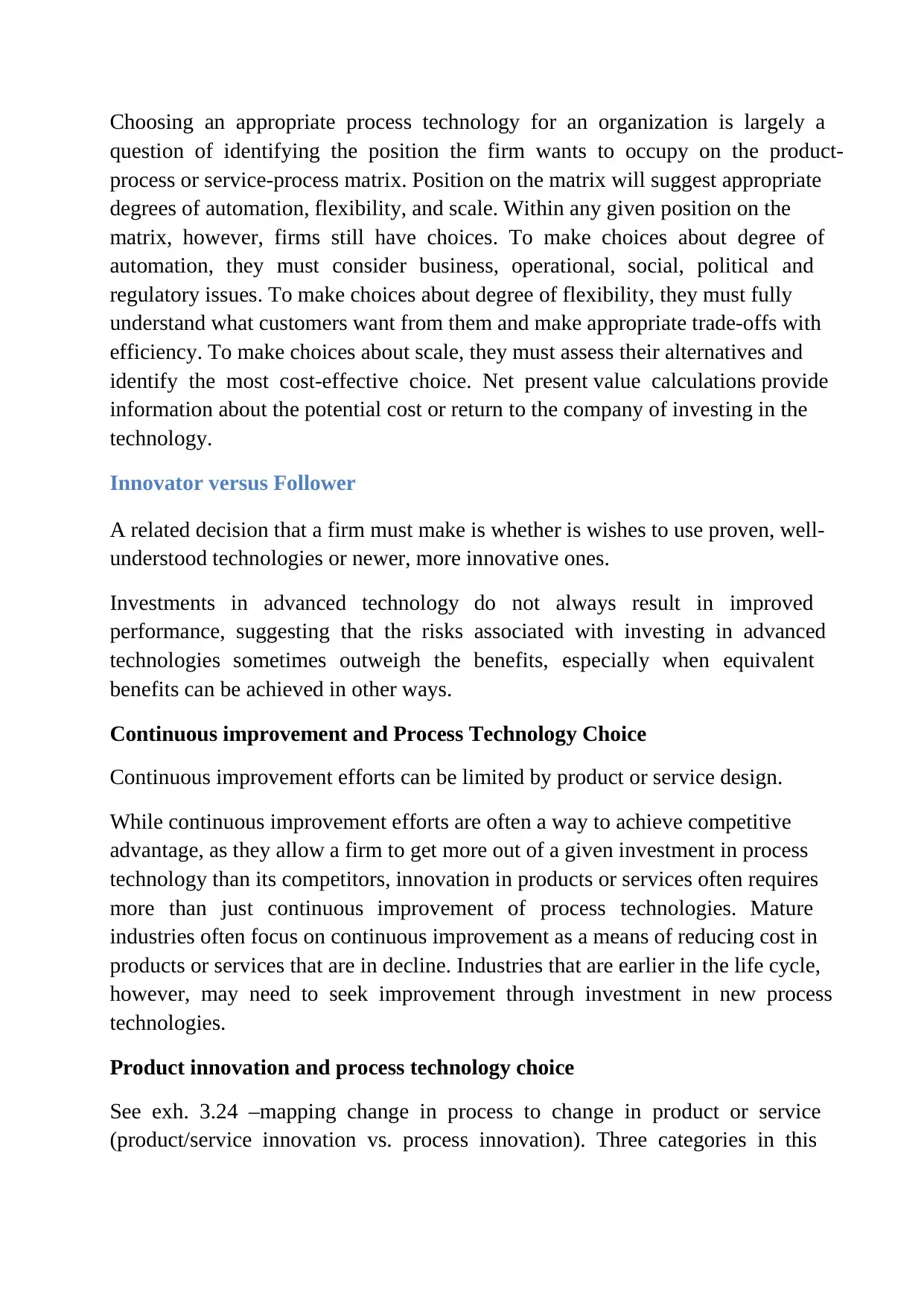
Choosing an appropriate process technology for an organization is largely a
question of identifying the position the firm wants to occupy on the product-
process or service-process matrix. Position on the matrix will suggest appropriate
degrees of automation, flexibility, and scale. Within any given position on the
matrix, however, firms still have choices. To make choices about degree of
automation, they must consider business, operational, social, political and
regulatory issues. To make choices about degree of flexibility, they must fully
understand what customers want from them and make appropriate trade-offs with
efficiency. To make choices about scale, they must assess their alternatives and
identify the most cost-effective choice. Net present value calculations provide
information about the potential cost or return to the company of investing in the
technology.
Innovator versus Follower
A related decision that a firm must make is whether is wishes to use proven, well-
understood technologies or newer, more innovative ones.
Investments in advanced technology do not always result in improved
performance, suggesting that the risks associated with investing in advanced
technologies sometimes outweigh the benefits, especially when equivalent
benefits can be achieved in other ways.
Continuous improvement and Process Technology Choice
Continuous improvement efforts can be limited by product or service design.
While continuous improvement efforts are often a way to achieve competitive
advantage, as they allow a firm to get more out of a given investment in process
technology than its competitors, innovation in products or services often requires
more than just continuous improvement of process technologies. Mature
industries often focus on continuous improvement as a means of reducing cost in
products or services that are in decline. Industries that are earlier in the life cycle,
however, may need to seek improvement through investment in new process
technologies.
Product innovation and process technology choice
See exh. 3.24 –mapping change in process to change in product or service
(product/service innovation vs. process innovation). Three categories in this
question of identifying the position the firm wants to occupy on the product-
process or service-process matrix. Position on the matrix will suggest appropriate
degrees of automation, flexibility, and scale. Within any given position on the
matrix, however, firms still have choices. To make choices about degree of
automation, they must consider business, operational, social, political and
regulatory issues. To make choices about degree of flexibility, they must fully
understand what customers want from them and make appropriate trade-offs with
efficiency. To make choices about scale, they must assess their alternatives and
identify the most cost-effective choice. Net present value calculations provide
information about the potential cost or return to the company of investing in the
technology.
Innovator versus Follower
A related decision that a firm must make is whether is wishes to use proven, well-
understood technologies or newer, more innovative ones.
Investments in advanced technology do not always result in improved
performance, suggesting that the risks associated with investing in advanced
technologies sometimes outweigh the benefits, especially when equivalent
benefits can be achieved in other ways.
Continuous improvement and Process Technology Choice
Continuous improvement efforts can be limited by product or service design.
While continuous improvement efforts are often a way to achieve competitive
advantage, as they allow a firm to get more out of a given investment in process
technology than its competitors, innovation in products or services often requires
more than just continuous improvement of process technologies. Mature
industries often focus on continuous improvement as a means of reducing cost in
products or services that are in decline. Industries that are earlier in the life cycle,
however, may need to seek improvement through investment in new process
technologies.
Product innovation and process technology choice
See exh. 3.24 –mapping change in process to change in product or service
(product/service innovation vs. process innovation). Three categories in this
⊘ This is a preview!⊘
Do you want full access?
Subscribe today to unlock all pages.

Trusted by 1+ million students worldwide
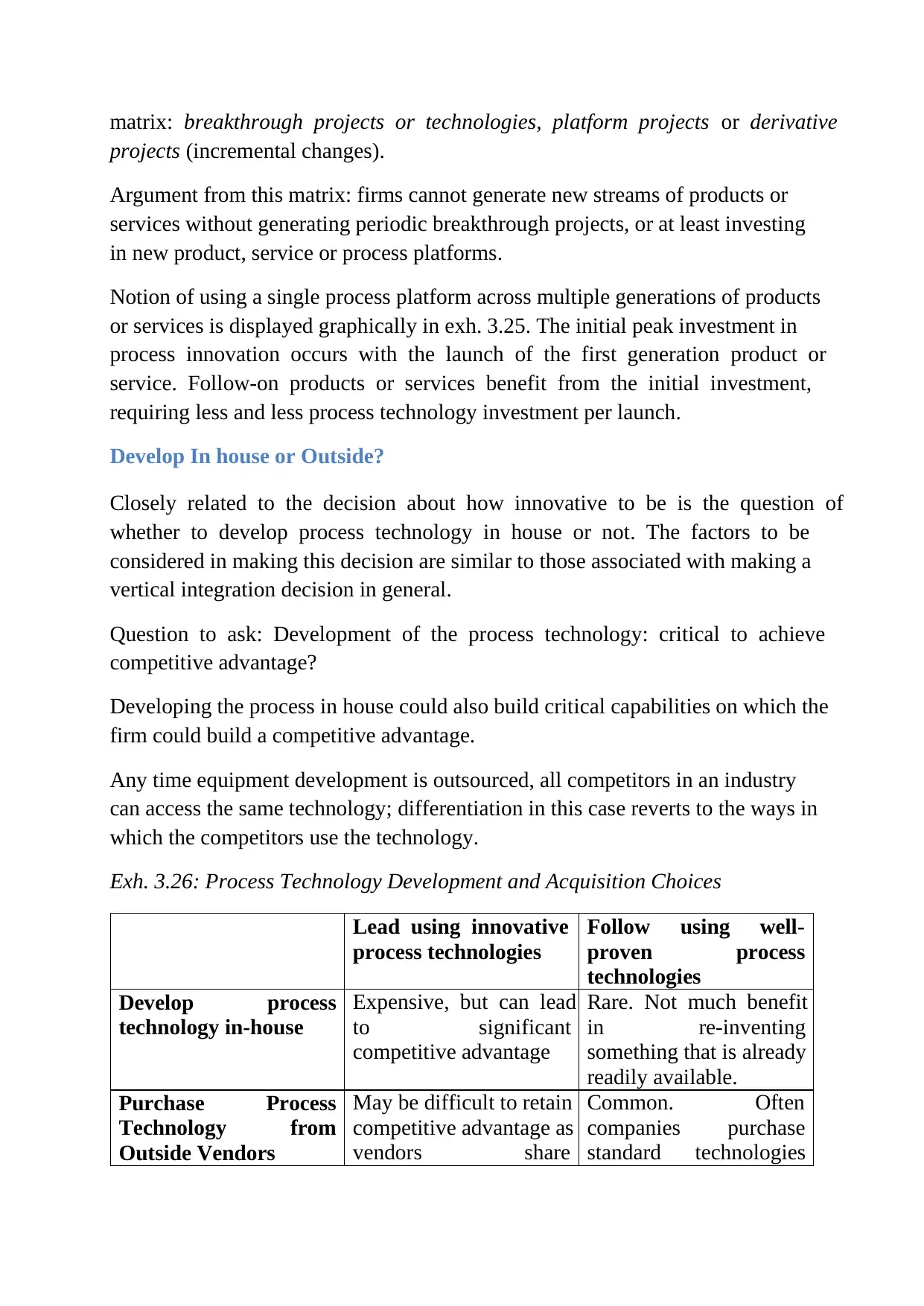
matrix: breakthrough projects or technologies, platform projects or derivative
projects (incremental changes).
Argument from this matrix: firms cannot generate new streams of products or
services without generating periodic breakthrough projects, or at least investing
in new product, service or process platforms.
Notion of using a single process platform across multiple generations of products
or services is displayed graphically in exh. 3.25. The initial peak investment in
process innovation occurs with the launch of the first generation product or
service. Follow-on products or services benefit from the initial investment,
requiring less and less process technology investment per launch.
Develop In house or Outside?
Closely related to the decision about how innovative to be is the question of
whether to develop process technology in house or not. The factors to be
considered in making this decision are similar to those associated with making a
vertical integration decision in general.
Question to ask: Development of the process technology: critical to achieve
competitive advantage?
Developing the process in house could also build critical capabilities on which the
firm could build a competitive advantage.
Any time equipment development is outsourced, all competitors in an industry
can access the same technology; differentiation in this case reverts to the ways in
which the competitors use the technology.
Exh. 3.26: Process Technology Development and Acquisition Choices
Lead using innovative
process technologies
Follow using well-
proven process
technologies
Develop process
technology in-house
Expensive, but can lead
to significant
competitive advantage
Rare. Not much benefit
in re-inventing
something that is already
readily available.
Purchase Process
Technology from
Outside Vendors
May be difficult to retain
competitive advantage as
vendors share
Common. Often
companies purchase
standard technologies
projects (incremental changes).
Argument from this matrix: firms cannot generate new streams of products or
services without generating periodic breakthrough projects, or at least investing
in new product, service or process platforms.
Notion of using a single process platform across multiple generations of products
or services is displayed graphically in exh. 3.25. The initial peak investment in
process innovation occurs with the launch of the first generation product or
service. Follow-on products or services benefit from the initial investment,
requiring less and less process technology investment per launch.
Develop In house or Outside?
Closely related to the decision about how innovative to be is the question of
whether to develop process technology in house or not. The factors to be
considered in making this decision are similar to those associated with making a
vertical integration decision in general.
Question to ask: Development of the process technology: critical to achieve
competitive advantage?
Developing the process in house could also build critical capabilities on which the
firm could build a competitive advantage.
Any time equipment development is outsourced, all competitors in an industry
can access the same technology; differentiation in this case reverts to the ways in
which the competitors use the technology.
Exh. 3.26: Process Technology Development and Acquisition Choices
Lead using innovative
process technologies
Follow using well-
proven process
technologies
Develop process
technology in-house
Expensive, but can lead
to significant
competitive advantage
Rare. Not much benefit
in re-inventing
something that is already
readily available.
Purchase Process
Technology from
Outside Vendors
May be difficult to retain
competitive advantage as
vendors share
Common. Often
companies purchase
standard technologies
Paraphrase This Document
Need a fresh take? Get an instant paraphrase of this document with our AI Paraphraser
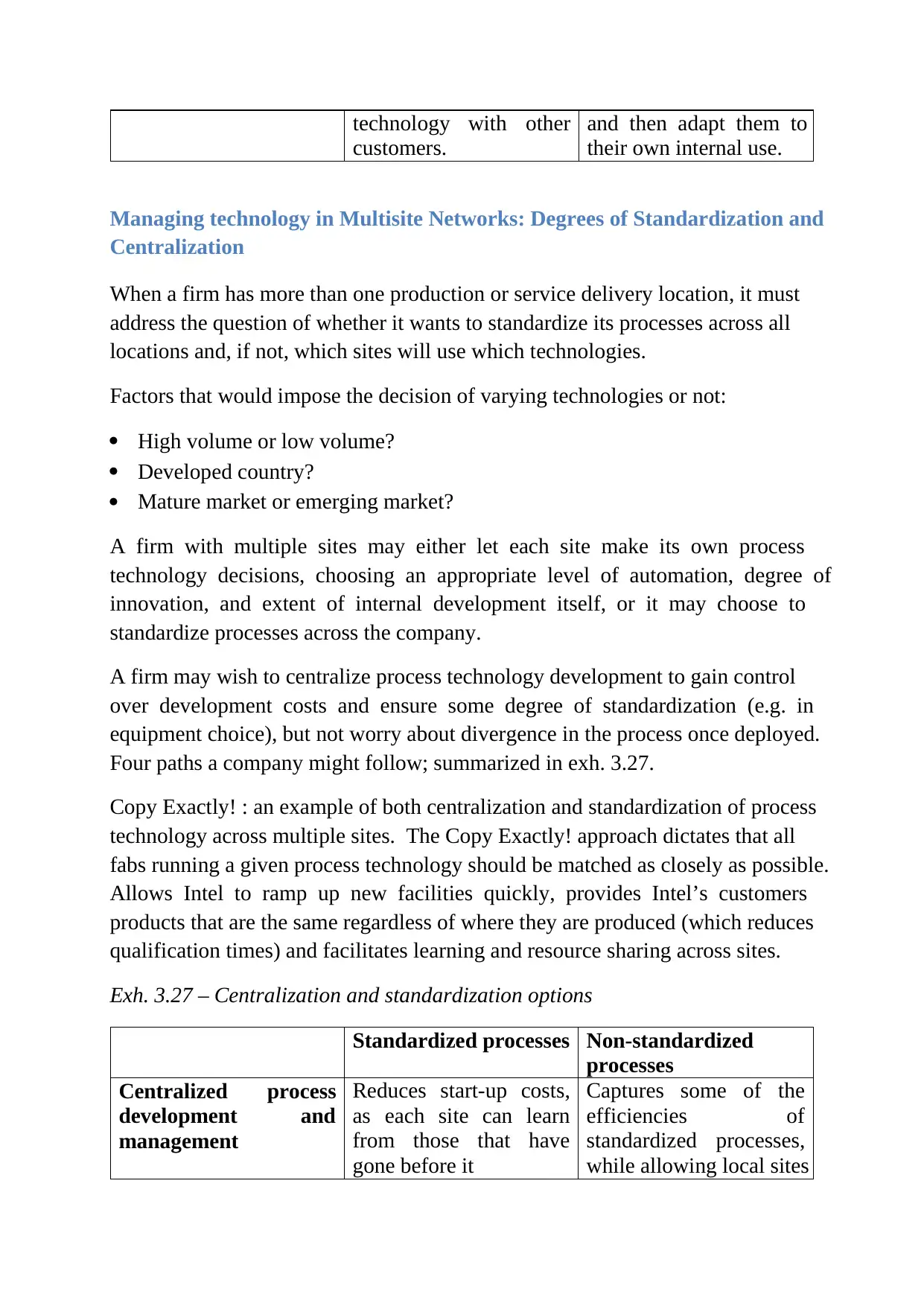
technology with other
customers.
and then adapt them to
their own internal use.
Managing technology in Multisite Networks: Degrees of Standardization and
Centralization
When a firm has more than one production or service delivery location, it must
address the question of whether it wants to standardize its processes across all
locations and, if not, which sites will use which technologies.
Factors that would impose the decision of varying technologies or not:
High volume or low volume?
Developed country?
Mature market or emerging market?
A firm with multiple sites may either let each site make its own process
technology decisions, choosing an appropriate level of automation, degree of
innovation, and extent of internal development itself, or it may choose to
standardize processes across the company.
A firm may wish to centralize process technology development to gain control
over development costs and ensure some degree of standardization (e.g. in
equipment choice), but not worry about divergence in the process once deployed.
Four paths a company might follow; summarized in exh. 3.27.
Copy Exactly! : an example of both centralization and standardization of process
technology across multiple sites. The Copy Exactly! approach dictates that all
fabs running a given process technology should be matched as closely as possible.
Allows Intel to ramp up new facilities quickly, provides Intel’s customers
products that are the same regardless of where they are produced (which reduces
qualification times) and facilitates learning and resource sharing across sites.
Exh. 3.27 – Centralization and standardization options
Standardized processes Non-standardized
processes
Centralized process
development and
management
Reduces start-up costs,
as each site can learn
from those that have
gone before it
Captures some of the
efficiencies of
standardized processes,
while allowing local sites
customers.
and then adapt them to
their own internal use.
Managing technology in Multisite Networks: Degrees of Standardization and
Centralization
When a firm has more than one production or service delivery location, it must
address the question of whether it wants to standardize its processes across all
locations and, if not, which sites will use which technologies.
Factors that would impose the decision of varying technologies or not:
High volume or low volume?
Developed country?
Mature market or emerging market?
A firm with multiple sites may either let each site make its own process
technology decisions, choosing an appropriate level of automation, degree of
innovation, and extent of internal development itself, or it may choose to
standardize processes across the company.
A firm may wish to centralize process technology development to gain control
over development costs and ensure some degree of standardization (e.g. in
equipment choice), but not worry about divergence in the process once deployed.
Four paths a company might follow; summarized in exh. 3.27.
Copy Exactly! : an example of both centralization and standardization of process
technology across multiple sites. The Copy Exactly! approach dictates that all
fabs running a given process technology should be matched as closely as possible.
Allows Intel to ramp up new facilities quickly, provides Intel’s customers
products that are the same regardless of where they are produced (which reduces
qualification times) and facilitates learning and resource sharing across sites.
Exh. 3.27 – Centralization and standardization options
Standardized processes Non-standardized
processes
Centralized process
development and
management
Reduces start-up costs,
as each site can learn
from those that have
gone before it
Captures some of the
efficiencies of
standardized processes,
while allowing local sites
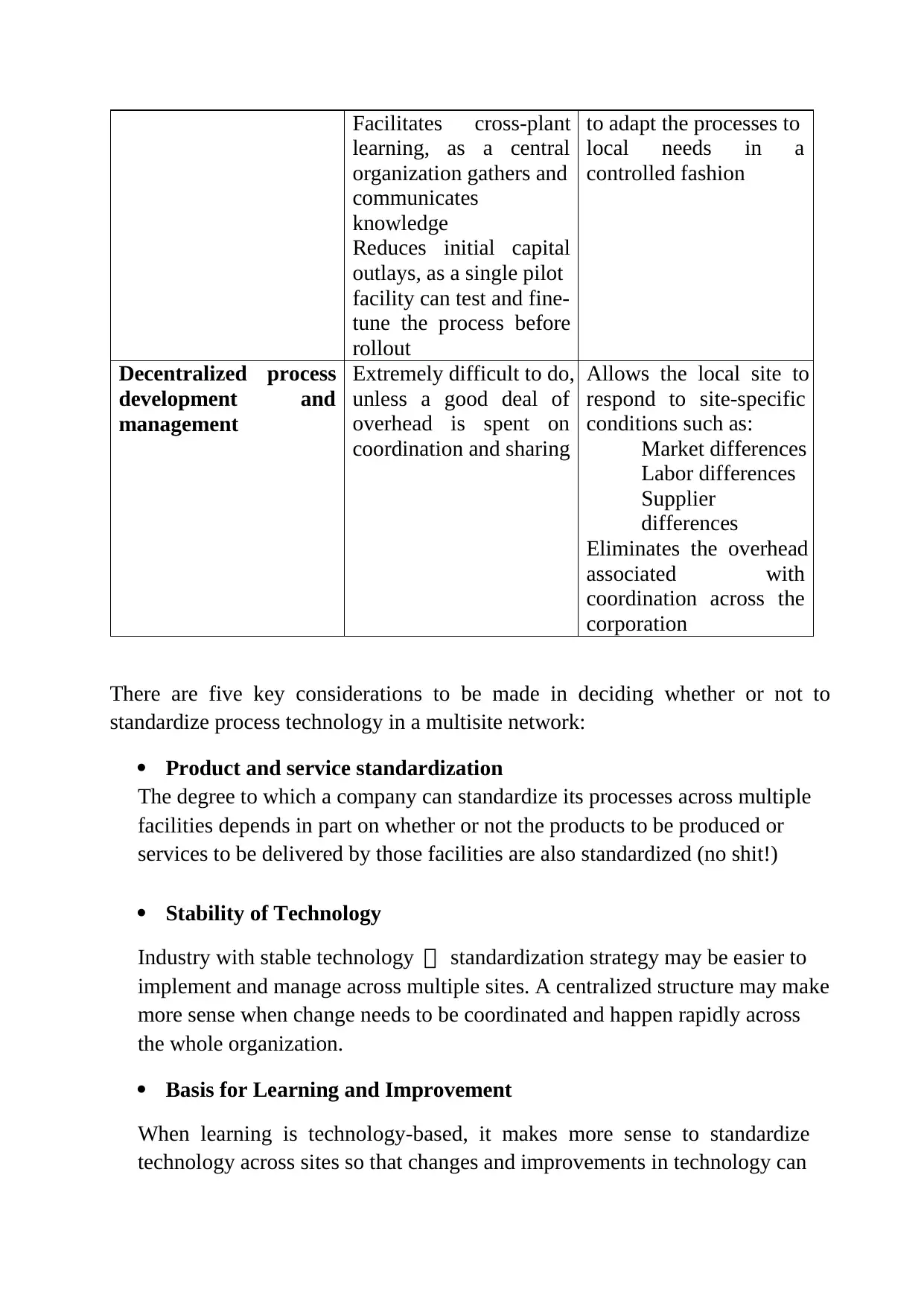
Facilitates cross-plant
learning, as a central
organization gathers and
communicates
knowledge
Reduces initial capital
outlays, as a single pilot
facility can test and fine-
tune the process before
rollout
to adapt the processes to
local needs in a
controlled fashion
Decentralized process
development and
management
Extremely difficult to do,
unless a good deal of
overhead is spent on
coordination and sharing
Allows the local site to
respond to site-specific
conditions such as:
Market differences
Labor differences
Supplier
differences
Eliminates the overhead
associated with
coordination across the
corporation
There are five key considerations to be made in deciding whether or not to
standardize process technology in a multisite network:
Product and service standardization
The degree to which a company can standardize its processes across multiple
facilities depends in part on whether or not the products to be produced or
services to be delivered by those facilities are also standardized (no shit!)
Stability of Technology
Industry with stable technology standardization strategy may be easier to
implement and manage across multiple sites. A centralized structure may make
more sense when change needs to be coordinated and happen rapidly across
the whole organization.
Basis for Learning and Improvement
When learning is technology-based, it makes more sense to standardize
technology across sites so that changes and improvements in technology can
learning, as a central
organization gathers and
communicates
knowledge
Reduces initial capital
outlays, as a single pilot
facility can test and fine-
tune the process before
rollout
to adapt the processes to
local needs in a
controlled fashion
Decentralized process
development and
management
Extremely difficult to do,
unless a good deal of
overhead is spent on
coordination and sharing
Allows the local site to
respond to site-specific
conditions such as:
Market differences
Labor differences
Supplier
differences
Eliminates the overhead
associated with
coordination across the
corporation
There are five key considerations to be made in deciding whether or not to
standardize process technology in a multisite network:
Product and service standardization
The degree to which a company can standardize its processes across multiple
facilities depends in part on whether or not the products to be produced or
services to be delivered by those facilities are also standardized (no shit!)
Stability of Technology
Industry with stable technology standardization strategy may be easier to
implement and manage across multiple sites. A centralized structure may make
more sense when change needs to be coordinated and happen rapidly across
the whole organization.
Basis for Learning and Improvement
When learning is technology-based, it makes more sense to standardize
technology across sites so that changes and improvements in technology can
⊘ This is a preview!⊘
Do you want full access?
Subscribe today to unlock all pages.

Trusted by 1+ million students worldwide
1 out of 18
Related Documents
Your All-in-One AI-Powered Toolkit for Academic Success.
+13062052269
info@desklib.com
Available 24*7 on WhatsApp / Email
![[object Object]](/_next/static/media/star-bottom.7253800d.svg)
Unlock your academic potential
Copyright © 2020–2025 A2Z Services. All Rights Reserved. Developed and managed by ZUCOL.





